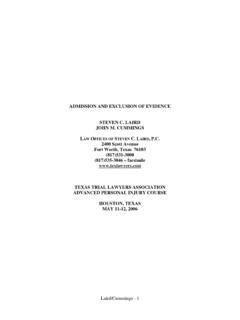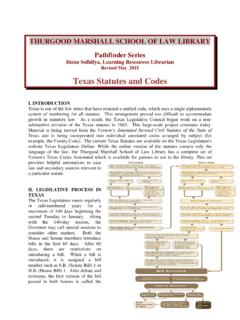Transcription of TEXAS VOIR DIRE - Law Offices of Steven C. Laird
1 TEXAS voir DIRE: AN AERIAL VIEW OF JURY DE-SELECTION Steven C. LairdLaw Offices of Steven C. Laird , INJURY ATTORNEYS1824 8th AvenueFort Worth, TEXAS 76110(817) 2, 2010 TABLE OF CONTENTS of voir Dire5 Shuffle of of voir Dire8 to for Cause Grounds for Striking Jurors for Bias Constitutes Bias? After an Expression of Into Issues of Bias - Using Peremptory Challenges for ImproperReasons14 of Error in voir Dire of Strikes for Cause16 TABLE OF AUTHORITIES Babcock v. Northwest Mem. Hosp., 767 705 (Tex. 1989)5 Barrett v. State, 516 181 (Tex. Crim. App. 1974)8 Batson v. Kentucky, 476 79, 106 1712 (1986)14 Brumfield v. Exxon Corp., 63 912 (Tex. App. Dallas2002, pet. denied)14, 15 Carr v. Smith, 22 128 (Tex. App. Fort Worth 2000,pet. denied)7 Compton v. Henrie, 364 179 (Tex. 1963)10 Cortez ex rel. Estate of Puentes v. HCCI-San Antonio, Inc.,159 87 (Tex. 2005)passimCortez v. HCCI-San Antonio, Inc., 131 113 (Tex. App.)
2 San Antonio 2004), aff d 159 87 (Tex. 2005)10 Davis v. Fisk, 187 570 (Tex. App. Houston [1st Dist.]2006, pet. granted)18 Edmonson v. Leesville Concrete Co., Inc., 500 614, 2077 (1991)14 Goode v. Shoukfeh, 943 441 (Tex. 1997)14, 15 Gum v. Schaffer, 683 803 (Tex. App. Corpus Christi1984, no writ) (per curiam), overruled by Cortez Estate of Puentes v. HCCI-San Antonio, Inc.,159 87 (Tex. 2005)22 Hafi v. Baker, 164 383 (Tex. 2005) (per curiam)10, 12, 13 Hyundai Motor Co. v. Vasquez, 189 743 (Tex. 2006)passimLassiter v. Bouche, 41 88 (Tex. Civ. App. Dallas 1931,writ ref d)6 Lopez v. Foremost Paving, Inc., 709 643 (Tex. 1986)(per curiam)8In re , 147 521 (Tex. App. Fort Worth 2004,pet. denied)8, 15, 16 McCoy v. Wal-Mart Stores, Inc., 59 793 (Tex. App. Texarkana 2001, no pet.)8 Molina v. Pigott, 929 538 (Tex. App. Corpus Christi1996, writ denied)11 Odom v. Clark, 215 571 (Tex. App. Tyler 2007, )9 Patterson Dental Co. v. Dunn, 592 914 (Tex.
3 1979)7 Pojar v. Cifre, 199 317 (Tex. App. Corpus Christi2006, pet. denied)16 Powers v. Palacios, 813 489 (Tex. 1991)14 Purkett v. Elem, 514 765, 115 1769 (1995)14 Ratliff v. State, 690 597 (Tex. Crim. App. 1985)(en banc)8 Van Allen v. Blackledge, 35 61 (Tex. App. Houston[14th Dist.] 2000, pet. denied)15 Vickery v. Behar, 2006 WL 1140685 (Tex. App. Houston[14th Dist.] Apr. 26, 2006, no pet.) (mem. op.)16 Welch v. McLean, 191 147 (Tex. App. Fort Worth2005, no pet.)15 White v. Dennison, 752 714 (Tex. App. Dallas 1998,writ denied)11 Whiteside v. Watson, 12 614 (Tex. App. Eastland2000, pet. w drawn)7 Authorities Tex. Const. art. 1, 155 Tex. Gov t Code Gov t Code Tex. R. Civ. Pro. 2236, 7 Tex. R. Civ. Pro. 2337 In many cases, the de-selection of the jury is at least as important as the facts and the law. Given the deference appellate courts are required to give to the jury s right to weigh the evidence, decide which witness is to be believed, to find facts, etc.
4 , the makeup of the jury can have an enormous effect not only on the outcome of the case but also of any subsequent appeal. Despite this, voir dire as a process can often receive surprisingly short shrift, being overlooked in the flurry of trial preparation, pretrial motions, witness preparation and the like. voir dire is a tricky thing. Compared with other aspects of trial practice, there are few hard and fast rules governing the conduct of voir dire. As crucial as voir dire is, there are no rules of civil procedure specifically governing how the entire process is to be conducted, or its permissible scope. In fact, it often seems as if every judge handles it in his or her own preferred way. voir dire also involves a balancing act on the part of the court. It must be limited enough to ensure it may be completed in a reasonable amount of time but flexible enough to accomplish its goal of identifying and removing those jurors who should not serve on the jury. On top of all this, it must be fair to both sides.
5 The following paper is intended to be a brief overview of voir dire as it occurs in the courtroom. of voir Dire To effectuate the purpose of voir dire to expose possible bias and prejudice in potential jurors litigants must be given broad latitude to question potential jurors. Hyundai Motor Co. v. Vasquez, 189 743, 749 (Tex. 2006); Cortez ex rel. Estate of Puentes v. HCCI-San Antonio, Inc., 159 87, 93 (Tex. 2005); Babcock v. Northwest Mem. Hosp., 767 705, 709 (Tex. 1989). Under the TEXAS Constitution litigants are entitled to a fair and impartial jury, Tex. Const. art. 1, 15, and one of the few tools available to accomplish this goal is the examination of the jury pool in voir dire. This fundamental purpose necessarily means the scope of voir dire cannot be overly limited by inflexible rules, because in order to expose the delicate nature of a potential bias voir dire must be inherently subjective, Hyundai Motor Co., 189 at 750, but this lack of inflexible rules does not mean voir dire cannot be subject to reasonable limits are necessary to protect against litigants using the examination improperly.
6 Since strict rules cannot be applied to such a subjective process, the best method of applying reasonable limitations is through the discretion of the trial court. It is well established that trial courts have broad discretion in conducting voir dire. Hyundai Motor, 189 at 753; Cortez, 159 at 92; Lassiter v. Bouche, 41 88, 90 (Tex. Civ. App. Dallas 1931, writ ref d). This is the case because trial judges are in the courtroom when the questions are asked, observe the demeanor of the jurors, and are in a better position altogether than outsiders to grasp the context in which voir dire questions are asked. Hyundai Motor, 189 at 755. Matters Shuffle Before beginning the actual Q and A of voir dire, counsel should first consider whether to seek a jury shuffle. A jury shuffle (colloquially known as a shake ) is the act of asking the Court to take all the jurors who have been seated, shuffle their names, and have them seated once again. Usually this is done because the party requesting the shuffle does not like the faces seated in at least places 1 through 24.
7 (Although see the discussion of Batson challenges below for the limits of counsel s ability to make decisions regarding the jury based on perceptions unrelated to information gleaned through voir dire.) A jury shuffle is permitted by Rule 223. A request that the jury be shuffled must be made before voir dire begins, or else it is waived. Carr v. Smith, 22 128, 133-34 (Tex. App. Fort Worth 2000, pet. denied). In those counties which use a juror questionnaire, the shuffle must be requested before the questionnaires are completed, because the questionnaire constitutes the beginning of voir dire. Carr, 22 at 133-34. What this means in counties where potential jurors complete their questionnaires before they even appear at the courthouse is not clear. Once a jury shuffle has been requested, the court is to place the names of all the members of the panel into a receptacle, shuffle them and then draw them out one at a time. Tex. R. Civ. Pro. 223. Interestingly, Rule 223 specifies that there may only be one jury shuffle per case, not one per side, so it is first come, first served.
8 However, the shuffle that occurs must be in compliance with the provisions of Rule 223; a shuffle done in some other way is not treated as a shuffle for the one shuffle per case provisions of the rule. Whiteside v. Watson, 12 614, 618 (Tex. App. Eastland 2000, pet. w drawn) (first jury shuffle was done by physically shuffling juror cards rather than drawing them from a receptacle; permitting second shuffle to be done in accordance with the rule was not error). of Strikes Another issue that is best addressed before voir dire actually begins is the equalization of strikes. The general rule is that litigants in district court are each entitled to six peremptory challenges and those in county court to three, but this general rule only applies strictly where there is one party on each side of the v . Tex. R. Civ. Pro. 233. In those cases where there are multiple parties, it is the trial court s duty to decide how the interests of the parties actually align, although only on the motion of a party.
9 Id. Based on the determination of who is actually adverse to whom, the court is supposed to equalize the number of peremptory challenges, Id., although to the extent it implies equal numbers the term equalization is a misnomer. Instead, the equalization is to prevent any side from enjoying an unfair advantage. Id. If it sounds like this gives trial courts a considerable degree of freedom in equalizing peremptory challenges, this is only because it does. The leading case on the issue is Patterson Dental Co. v. Dunn, 592 914 (Tex. 1979). In Patterson Dental the Supreme Court approved a court either increasing the number of strikes afforded one side or decreasing the number of strikes afforded the other, and rejected the idea that a fixed ratio of strikes-to-sides was required, although at some point too great a disparity (in the case, four-to-one) was so high as to itself be unfair. Patterson Dental, 592 at 920-21. Additionally, the question of when litigants are allowed to coordinate the use of their strikes can also affect equalization determinations; permitting coordination can show the number of strikes given a side is unfairly high, since coordination implies the parties are not genuinely antagonistic (and therefore likely do not need more than the normal number of strikes non-antagonistic parties are allowed), and because allows the strikes they are given to be used as efficiently as possible, , without the danger of double strikes.
10 Lopez v. Foremost Paving, Inc., 709 643, 645 (Tex. 1986) (per curiam); In re , 147 521, 532 (Tex. App. Fort Worth 2004, pet. denied). As a matter of good practice, if you are litigating a case with a number of parties on the other side, you should consider filing a motion to equalize the strikes and have it heard before the jury is cooling its heels out in the hall. At the very least it will allow you to know going in how many strikes you and your opponents will have to work with when it comes time to seat the jury. of voir Dire Finally, there is the question of how long you will get for voir dire. This time can vary wildly from court to court, and there is no set rule (or even fixed practice) governing the amount of time provided, although it has been recognized that trial courts have the right to limit the time spent on voir dire, Cortez, 159 at 92, and the time allowed seems more frequently gets shorter and shorter. Many of the cases discussing this issue in any detail are criminal cases, but their holdings are instructive and show that no time limit on voir dire is per se proper or improper, and the analysis of the question will depend on the facts.




